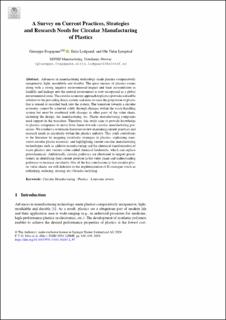A Survey on Current Practices, Strategies and Research Needs for Circular Manufacturing of Plastics
Peer reviewed, Journal article
Accepted version
Permanent lenke
https://hdl.handle.net/11250/3096791Utgivelsesdato
2023Metadata
Vis full innførselSamlinger
Originalversjon
Lecture Notes in Mechanical Engineering. 2023, 2, 842-849. 10.1007/978-3-031-38165-2_97Sammendrag
Advances in manufacturing technology made plastics comparatively inexpensive, light, mouldable and durable. The great success of plastics comes along with a strong negative environmental impact and their accumulation in landfills and leakage into the natural environment is now recognized as a global environmental crisis. The circular economy approach to plastics provides a feasible solution to the prevailing linear system and aims to raise the proportion of plastic that is reused or recycled back into the system. The transition towards a circular economy, cannot be achieved solely through changes within the waste-handling system but must be combined with changes in other parts of the value chain, including the design, the manufacturing, etc. Plastic manufacturing companies need support in the transition. Therefore, this study aims to provide knowledge to plastics companies to move from linear towards circular manufacturing processes. We conduct a systematic literature review examining current practices and research needs in circularity within the plastics industry. This study contributes to the literature by mapping circularity strategies in plastics, explaining innovative circular plastic materials, and highlighting current circular manufacturing technologies such as additive manufacturing and the chemical transformation of waste plastics into various value-added chemical feedstocks, which can replace petrochemicals. Additionally, circular pathways are illustrated to support practitioners in identifying their current position in the value chain and understanding pathways to increase circularity. One of the key conclusions is that circular plastic value chains are still deficient in the implementation of R-strategies (such as rethinking, reducing, reusing, etc.) besides recycling.
